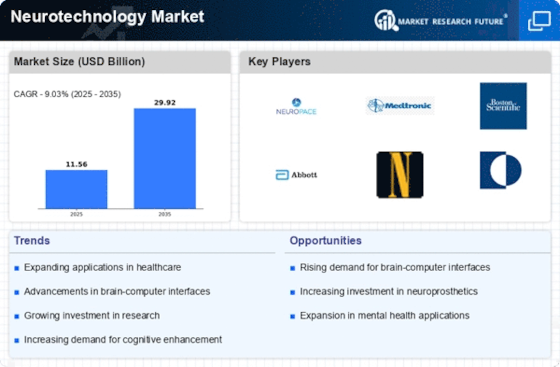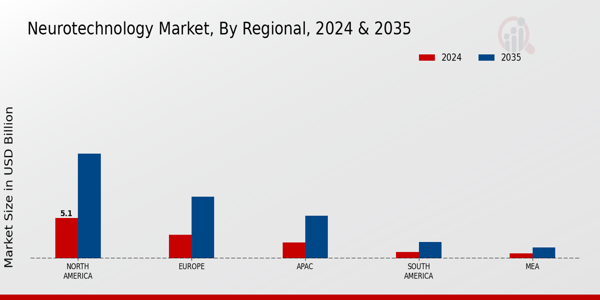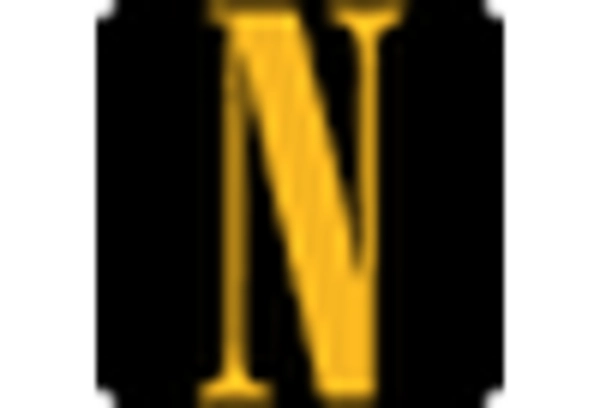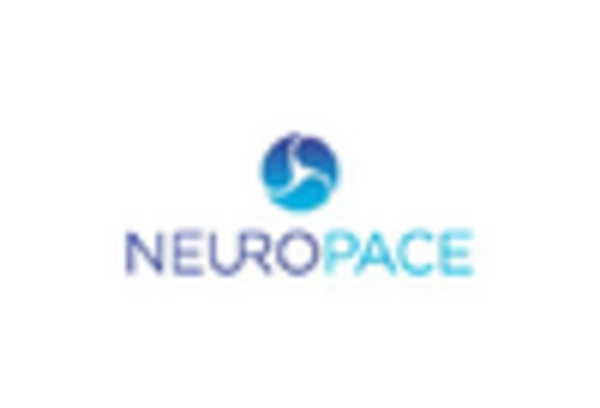Rising Demand for Neurodiagnostic Tools
The Neurotechnology Market is experiencing a notable increase in demand for neurodiagnostic tools, driven by the growing prevalence of neurological disorders. Conditions such as epilepsy, Alzheimer's disease, and multiple sclerosis are becoming more common, necessitating advanced diagnostic solutions. The market for neurodiagnostic devices is projected to reach approximately 10 billion USD by 2026, reflecting a compound annual growth rate of around 8 percent. This surge is attributed to the need for early detection and monitoring of neurological conditions, which can significantly improve patient outcomes. Furthermore, advancements in imaging technologies and the integration of artificial intelligence in neurodiagnostic tools are enhancing their accuracy and efficiency. As healthcare providers seek to adopt innovative solutions, the Neurotechnology Market is poised for substantial growth in this segment.
Growing Awareness of Mental Health Issues
The rising awareness of mental health issues is significantly influencing the Neurotechnology Market. As society becomes more cognizant of the importance of mental well-being, there is an increasing demand for neurotechnological solutions that address mental health disorders. The market for neurostimulation devices, which are used to treat conditions such as depression and anxiety, is projected to grow substantially, with estimates suggesting a value of over 5 billion USD by 2025. This growth is driven by the need for effective treatment options that are less invasive than traditional therapies. Additionally, the integration of neurotechnology in therapeutic practices is gaining traction, as practitioners seek innovative ways to enhance patient care. The Neurotechnology Market is thus positioned to expand as mental health awareness continues to rise, leading to greater acceptance and utilization of neurotechnological interventions.
Technological Advancements in Neurodevices
Technological advancements in neurodevices are playing a pivotal role in shaping the Neurotechnology Market. Innovations such as miniaturization, improved connectivity, and enhanced data analytics capabilities are making neurodevices more effective and user-friendly. For example, the development of wireless neurostimulation devices has revolutionized treatment options for patients with chronic pain and neurological disorders. The market for these devices is expected to grow at a compound annual growth rate of approximately 10 percent over the next five years. Furthermore, the integration of machine learning algorithms is enabling more personalized treatment approaches, which could lead to better patient outcomes. As technology continues to evolve, the Neurotechnology Market is likely to witness an influx of new products that cater to diverse patient needs, thereby expanding its reach and impact.
Increased Investment in Neurotechnology Research
Investment in neurotechnology research is witnessing a significant uptick, which is likely to propel the Neurotechnology Market forward. Governments and private entities are allocating substantial funds to explore the potential of neurotechnological innovations. For instance, funding for brain research initiatives has increased by over 15 percent in recent years, indicating a strong commitment to advancing the field. This influx of capital is facilitating the development of novel neurotechnologies, including brain-computer interfaces and neuroprosthetics. As research progresses, the commercialization of these technologies is expected to create new market opportunities. The collaboration between academic institutions and industry players is also fostering innovation, leading to the emergence of cutting-edge solutions that address various neurological challenges. Consequently, the Neurotechnology Market stands to benefit from this enhanced focus on research and development.
Regulatory Support for Neurotechnology Innovations
Regulatory support for neurotechnology innovations is emerging as a crucial driver for the Neurotechnology Market. Governments and regulatory bodies are increasingly recognizing the potential benefits of neurotechnological advancements and are streamlining approval processes for new devices and therapies. This supportive regulatory environment is fostering innovation and encouraging companies to invest in the development of novel neurotechnologies. For instance, expedited pathways for the approval of breakthrough devices are being established, which could significantly reduce the time to market for innovative solutions. As a result, the Neurotechnology Market is likely to see a surge in new product launches and advancements that address unmet medical needs. This regulatory backing not only enhances the credibility of neurotechnological solutions but also instills confidence among investors and stakeholders, further propelling market growth.


















Leave a Comment